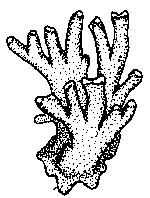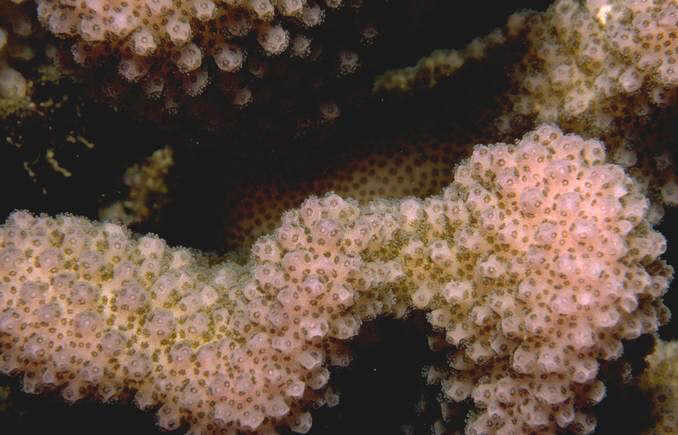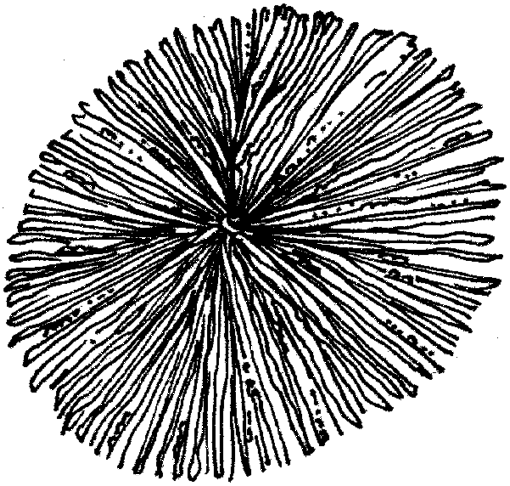 The pieces in your
kit represent only a small group that make up the Phylum Cnidaria. Corals are
usually referred to when people talk about warm, clean areas like Florida,
Hawaii or Australia. This is so, because coral are sensitive to changes in
water conditions, without the right conditions the corals will not survive.
The part that you have in your kit, is the skeleton that the animal makes. The
animal itself has most of the characteristics listed above. Corals usually
make good fossils because they leave behind their skeleton. The three types
that you have represent two different types of living The pieces in your
kit represent only a small group that make up the Phylum Cnidaria. Corals are
usually referred to when people talk about warm, clean areas like Florida,
Hawaii or Australia. This is so, because coral are sensitive to changes in
water conditions, without the right conditions the corals will not survive.
The part that you have in your kit, is the skeleton that the animal makes. The
animal itself has most of the characteristics listed above. Corals usually
make good fossils because they leave behind their skeleton. The three types
that you have represent two different types of living  habits.
The branching coral or stem coral is a colony. It is made up of many
individuals that live together on a common skeleton. Each opening represents
where each of the individuals lived. The mushroom and flower coral on the
other hand is an individual. One animal made this skeleton. The many radiating
walls (septa) helped support the animal when it was alive. Emphasize with your
students the difference between colonies and individuals and to make sure they
understand that the real animal looked like an upside down jellyfish, whose
tentacles capture food. habits.
The branching coral or stem coral is a colony. It is made up of many
individuals that live together on a common skeleton. Each opening represents
where each of the individuals lived. The mushroom and flower coral on the
other hand is an individual. One animal made this skeleton. The many radiating
walls (septa) helped support the animal when it was alive. Emphasize with your
students the difference between colonies and individuals and to make sure they
understand that the real animal looked like an upside down jellyfish, whose
tentacles capture food.
KEY POINTS:
- includes hydroids, jellyfish, sea anemones, and corals
- lives near shore to deep ocean depths
- ranges in size from one millimeter to several meters
- all have radial symmetry
- sac-like body has central body cavity
- body wall consists of 3 layers
- single opening serves as both mouth and anus and is surrounded by
food capturing tentacles
- stinging cells (nematocysts)
|
|
 The pieces in your
kit represent only a small group that make up the Phylum Cnidaria. Corals are
usually referred to when people talk about warm, clean areas like Florida,
Hawaii or Australia. This is so, because coral are sensitive to changes in
water conditions, without the right conditions the corals will not survive.
The part that you have in your kit, is the skeleton that the animal makes. The
animal itself has most of the characteristics listed above. Corals usually
make good fossils because they leave behind their skeleton. The three types
that you have represent two different types of living
The pieces in your
kit represent only a small group that make up the Phylum Cnidaria. Corals are
usually referred to when people talk about warm, clean areas like Florida,
Hawaii or Australia. This is so, because coral are sensitive to changes in
water conditions, without the right conditions the corals will not survive.
The part that you have in your kit, is the skeleton that the animal makes. The
animal itself has most of the characteristics listed above. Corals usually
make good fossils because they leave behind their skeleton. The three types
that you have represent two different types of living  habits.
The branching coral or stem coral is a colony. It is made up of many
individuals that live together on a common skeleton. Each opening represents
where each of the individuals lived. The mushroom and flower coral on the
other hand is an individual. One animal made this skeleton. The many radiating
walls (septa) helped support the animal when it was alive. Emphasize with your
students the difference between colonies and individuals and to make sure they
understand that the real animal looked like an upside down jellyfish, whose
tentacles capture food.
habits.
The branching coral or stem coral is a colony. It is made up of many
individuals that live together on a common skeleton. Each opening represents
where each of the individuals lived. The mushroom and flower coral on the
other hand is an individual. One animal made this skeleton. The many radiating
walls (septa) helped support the animal when it was alive. Emphasize with your
students the difference between colonies and individuals and to make sure they
understand that the real animal looked like an upside down jellyfish, whose
tentacles capture food.